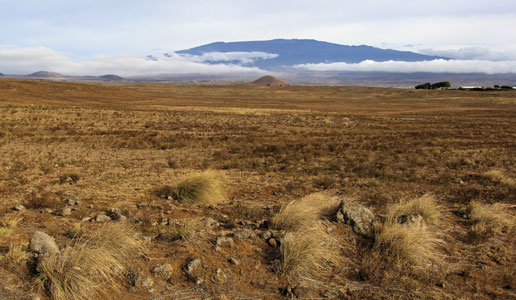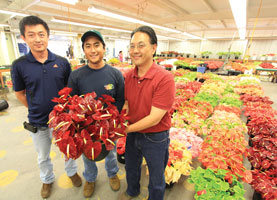11/26/2013
Growing on the Big Island
Chris Beytes

Yes, the Big Island is big.
I know. I’ve driven across and around most of the 4,000 square-mile island of Hawaii, better known as the Big Island. (For comparison, Delaware is 2,489 square miles.) My assignment: visit an assortment of agricultural operations, including orchids, foliage, papaya, banana and even macadamia nuts. My goal: learn enough about the horticulture and agriculture industries here to sound somewhat intelligent when addressing the 5th Annual Hawaiian Tropical Flower Council & Hawaiian Floriculture & Nursery Association Conference. It’s a big title for a small but enthusiastic group of Hawaii Island growers who, like growers everywhere, are looking to improve their businesses.
Like all my travels, I don’t pretend to become an expert on a place in just a few days. But I am pretty good at making educated observations. Here are a few:
Not a tourist trap
Hawaii, the island, is not nearly as touristy as the rest of the archipelago. No one bedecked me with a lei when I got off the airplane, and rather than the strumming of ukuleles, I were serenaded only by the loud chirps of the ubiquitous and invasive coqui frog (for which growers have to hot water-treat plants before shipping to California). You want the tourist spots, go to Oahu.
The Big Island’s two main cities, Hilo (my base, on the east side) and Kona (straight across on the west coast) are laid-back small towns with a hip island vibe and a refreshingly small number of tourist attractions—other than the world’s most active volcano, Kilauea, that is (which, due to the government shutdown, was closed).
A very varied landscape
The landscape and climate of the Big Island are amazingly varied. From tropical jungle to lava-strewn moonscape to Texas cattle ranch to green Irish hillside and back to the jungle again in a day’s drive around the island. With accompanying wet-to-dry weather conditions. Whatever you think it looks like, it does—and a whole lot more. I could fill this article with landscape photographs.
However, while the island’s two tallest volcanoes, Mauna Loa and Mauna Kea, reach 13,678 ft. and 13,796 ft. respectively, you never sense that great height, because the slopes are so gradual (about 12 degrees). They’re just really big mounds.
Not many IGCs
One of my goals was to visit the local garden centers, but I only found a few, including a Home Depot (there are seven in the state). There just doesn’t seem to be much call for nursery products. That could be because the local economy is based mainly on agriculture and tourism, or because the landscape is already ablaze with tropical foliage and flowers growing wild. Depot’s garden center was loaded with interesting tropical flowers and fruit, and even a few racks of typical mainland annuals such as impatiens and marigolds. Orchids and bromeliads abound, of course. Prices seemed in line with what we might pay here.
I dropped in on one independent, Rozett’s Nursery; however, the owner, Donna Rozett, wasn’t in. I left my card, and Donna sent me a nice email the next day. In reply, I asked her to tell me a bit about the Hawaiian retail market. Here’s what she said:
“Retail is a bit of a challenge here, because people like to trade cuttings with each other, and very few people have houseplants. Most of the Puna district where we are located has very little, if any, soil on top of lava flows, so [consumers] need to be educated before they can successfully landscape. The Big Island also has a very small population.
With all of that being said, we are off the beaten track but in the fastest-growing area on the island, and the new people who are buying here are from the mainland and used to landscaping their yards, so we anticipate a gradual increase in sales here in the coming years.”
Pict ured: There are more than 40 varieties of cut anthurium at Eric Tanouye’s Green Point Nurseries. They harvest 30,000 to 40,000 stems per week. That’s Eric on the right; his son, Jon, center; and production manager Neo Thong-Teng on the left.
ured: There are more than 40 varieties of cut anthurium at Eric Tanouye’s Green Point Nurseries. They harvest 30,000 to 40,000 stems per week. That’s Eric on the right; his son, Jon, center; and production manager Neo Thong-Teng on the left.
Local market is limited
As Donna said, there is a local market for flowers and plants in the state, but export to the mainland and Asia is the big business. Canada is on their radar as well, if they work the regulatory hurdles. There are only so many locals to sell to, and only so many island resorts needing orchids. Still, there are some burgeoning Hawaiian markets, such as destination weddings, which make use of the islands cut orchids and anthuriums.
Growers here are laid back
Nobody loses sleep over business in Hawaii. Or, if they do, they don’t admit it. When I ask that question on the mainland, growers give me a litany of problems. Here, they smile and say, “I sleep pretty good.” Not that they don’t have problems: namely shipping costs, labor and anti-herbicide/anti-GMO/anti non-organic factions. But there’s a laid-back attitude here that has everybody pretty relaxed, at least on the surface.
Sometimes too laid back
That laid-back attitude can get them in trouble. Eric Tanouye, a second-generation cut anthurium grower and one of Hawaii floriculture’s movers and shakers, admitted that he and the rest of the local anthurium industry was asleep when Dutch growers came here, selected the best Hawaiian-bred genetics, took them back to Holland, and are now competing strongly for the business.
But Eric isn’t taking it lying down; I don’t know any other grower more driven to organize his industry. He and others have even joined the papaya, coffee and nursery growers into a group called SHAC—the Synergistic Hawaii Agricultural Council, which represents 543 businesses. Joining together will give them the mass to qualify for state and federal overseas marketing grants.
Fantastic growing conditions
You can grow anything here, and it grows beautifully. Says foliage grower Enrique Martinez: “I think anyone can be a grower in Hawaii.” There are few pests, and the climate is as idyllic as you’ll find anywhere. The result is some truly stunning plant material, much if not most of which winds up in interiorscapes. Enrique, of California & Hawaii Foliage Growers, specializes in dracaena and palms that go primarily to that market.
What’s most amazing is how ratty his canes look when brought them in from the field and how perfect they are after just three months of rooting, feeding and cleaning. Oh, with 127 in. of rainfall a year, irrigation around Hilo is redundant and mostly unnecessary. (They had been in a bit of a dry spell before my visit, but it rained every day I was there.)
Inputs 30% higher
Just because the growing conditions are ideal, don’t start shopping for island property just yet. Inputs costs are, on average, 30% higher here says Mike Hughes of Hawaiian Tropicals Direct. Then there’s the cost of shipping your product to the mainland, which adds dollars to the cost of your finished product. It had better look spectacular!
Mike and his wife, Yachi, have been in Hawaii just a year. He’s from Michigan, where he spent 20 years with Henry Mast/Masterpiece. Yachi is from Taiwan and has her own import/export business, Tradewind Connection, which sells hard goods such as orchid-growing supplies. Mike and Yachi bought a nursery and are making a major investment in cut and pot orchids, hoping to one day be the biggest orchid grower in the state. Customers range from Alaska to Florida, and include Safeway, Whole Foods, Costco, Home Depot and many more.
Leaders in environmentalism
Hawaii is one of the front lines of the environmental movement. That means growers here will have to be at the forefront of modern growing technology. Hand-painted “No spray” signs abound on private property, a message for road crews applying herbicides to keep back the native flora. (There’s even a website,
www.nosprayhawaii.com.)
Ken Ogawa, a technical sales rep with Crop Production Services who, with Mike Hughes, toured me around, told me the desire of some Hawaiians is to have all farming “small and organic.”
GMOs are one such battlefield. There’s a bill pending on the Big Island to outlaw the outdoor cultivation of any GMO plant. Papaya, however, would be grandfathered in, because the only commercially viable variety right now is a GMO called Rainbow (which is resistant to a deadly virus). But beyond that, the public debate and controversy has brought negative publicity to papaya farmers like Alberto Belmes of A&T Belmes Farms, who’ve seen a drop in sales on the mainland from some buyers.
Local branding
There’s some good local branding and marketing taking place here. Certainly, everyone knows Mauna Loa Macadamia Nuts. They’re in every minibar from Las Vegas to Tokyo. But small producers, such as Mike Terring and his son, Young, of Ohana Banana Farm, have their own brands. The Terrings grow about 100 acres of apple bananas, a small, sweet variety from Brazil.
To separate theirs from the rest of the bunch, Young came up with the “Hawaiian Candy Apple Banana” brand (
www.applebananas.com). They sell mail order, but most of their production stays on the islands. (Shipment to the mainland requires irradiation, which many customers don’t like).
Mike’s next frontier is dried bananas, which are light (low-cost shipping) and don’t require irradiation. He says Safeway is very interested.
Labor challenging here, too
Other than shipping, labor is their big problem. At the places I visited, workers were mainly from the Philippines and Micronesia. Even so, labor costs are high. While minimum wage is $7.25 per hour, same as the national minimum, since 1974 the state has required employers to provide health care benefits to all employees who work more than 20 hours per week.
Although, according to an article in the New York Times, Hawaii “is a state where regular milk sells for $8 a gallon, gasoline costs $3.60 a gallon and the median price of a home in 2008 was $624,000—the second-highest in the nation. Despite this, Hawaii’s health insurance premiums are nearly tied with North Dakota for the lowest in the country, and Medicare costs per beneficiary are the nation’s lowest.” So employees should be healthier … if you could find them. Oh, gasoline was $4.16 when I visited.
So in the end, what’s it like to be a grower in Hawaii? Just as challenging as anyplace else … with the added fun of volcanoes and tsunamis.
GT